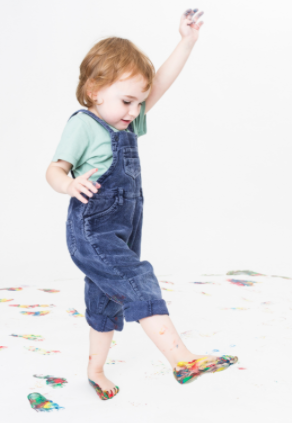Awkward Running or Walking? Physical Therapy Can Help!
Do you ever feel like when your child is active that they look awkward running or that something is off when they are walking? Does your child duck walk or walk pigeon toed? Maybe they also run in that position? You may be curious what on earth can physical therapists really do about it. Well, this blog post is here to answer those questions.
Awkward Running or Walking: The Interview
First, when you arrive to a pediatric physical therapy session with your child you will be interviewed briefly by the therapist. The PT will want to know what your concerns are. Similarly, they will want to get an idea of your child’s developmental history. Such as when did they crawl, how long did they crawl, when did they walk on their own, etc. They will ask when you first noticed the walking/running pattern. 
In addition, You should tell your therapist if there is a family history of duck or pigeon walking. Along with what (if anything) helped other family members. The PT will also want to know about sleeping and sitting positions your child prefers. All of these questions, and potentially more, will help the PT develop an accurate picture of your child’s presentation. After that, the interview process the evaluation will begin!
The Evaluation
This is the fun part. The PT will watch your child move, take measurements, and complete different assessments. These will help to determine the root cause of the awkward running or in-toe/out-toe position of the legs. No worries if your child is shy or nervous. Pediatric physical therapists have a wide variety of fun and engaging ways to get your child excited about the evaluation.
Development of The Plan
Once the PT has determined what is primarily leading to your child’s walking and/or running pattern the plan for how to correct it begins. Sometimes, this may be simple reassurance that your child’s walking/running pattern is normal for their age and their development. Other times, you and the PT will come up with a plan of action of how to best address the evaluation findings that are contributing to the awkward run or walk. For instance, here are a few things that may be involved in that plan.
- → Positioning: The PT may prescribe a home program that involves a varied sitting pattern such as avoidance of W sitting, which often times can lead to abnormal postures when standing and walking.
- → Footwear: The therapist may suggest modification of what type of shoes your child wears to better support the arches of the foot. They may recommend therapeutic taping or supportive inserts to improve the leg alignment of your child.
- → Strengthening: Often, the PT will determine an area of muscles (core, back, hips, lower leg) that will need some strengthening or stabilizing through resistive exercise.
- → Stretching: PT’s may also discover different muscles that may be tight that are contributing to the less than optimal running or walking patterns.
- → Gait and Functional Retraining: The heart of pediatric physical therapy! Using verbal, visual, and tactile cues to help your child learn to move in the best alignment possible.
- → Play: Each and every pediatric physical therapy treatment involves plenty of creative play. Above all, the goal is to make the other areas of the plan seem like something they actually want to be doing!
Conclusion: Make a Plan to Treat Awkward Running or Walking
In conclusion, If you are thinking that a physical therapy evaluation might be just what your child needs, please call Chicago Pediatric Therapy & Wellness Center at (773) 687-9241 to schedule a pediatric walking and running assessment today. For more Physical Therapy and Pediatric content make sure to follow us on Facebook, Instagram, and YouTube.



